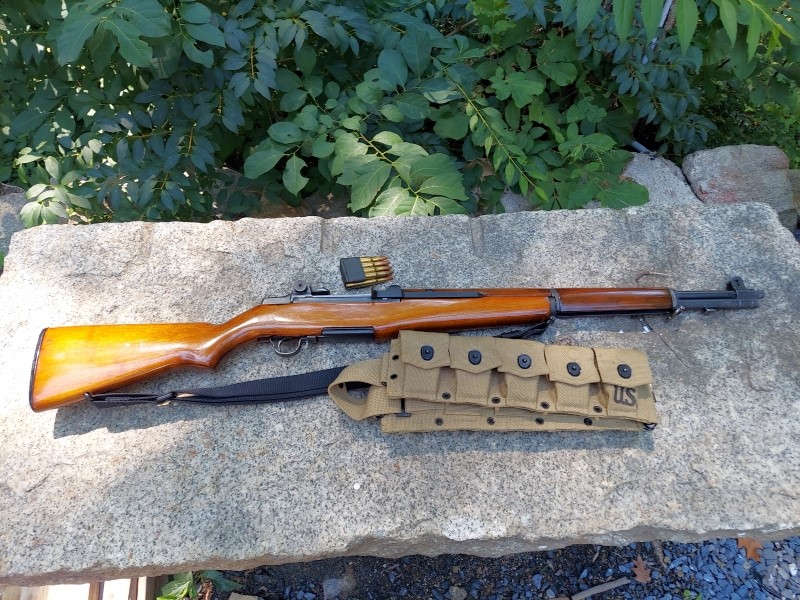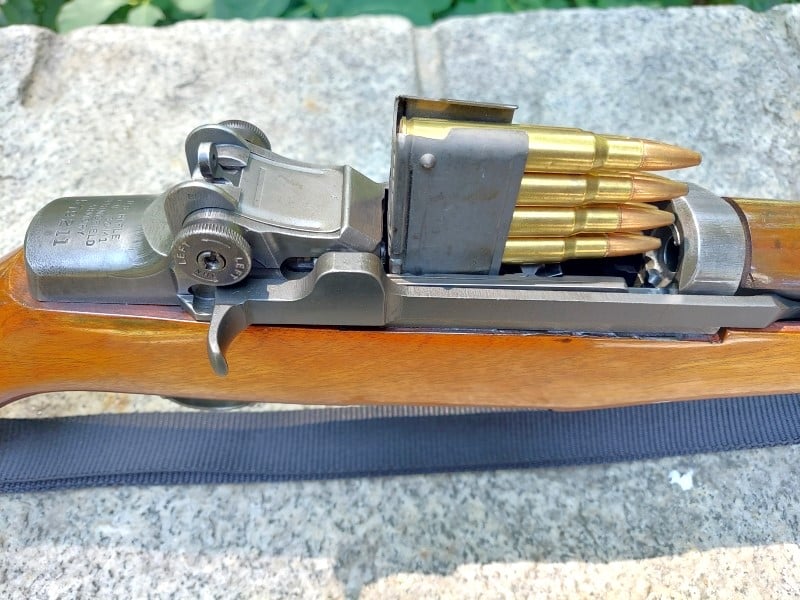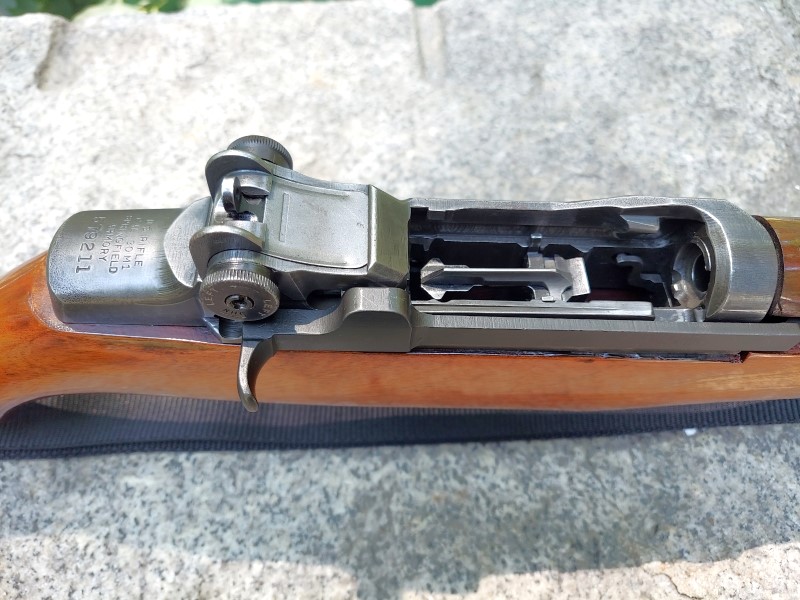John Cantius Garand (born in 1888 in Quebec, Canada) became an employee of Springfield Armory in 1919, having an extensive background in design and production. There, he began working on a semi-automatic rifle design that was based on an earlier machine gun that he had designed. For the next 17 years, he would perfect the design until, on January 9, 1936, the M-1 Garand was adopted.

Amazingly, Garand never received any monetary award for his invention besides his civil service salary. At one point, congress introduced a bill to award Garand $100,000, but it did not pass. Instead, he was awarded a medal for Meritorious Service in 1941. Then in 1944, he received another medal, a US Government Medal For Merit. Considering that his invention allowed the US to be the only country to arm its troops with a general-issue semi-auto rifle in WWII, this seems to be very light compensation. Mr. Garand retired from Springfield Armory in 1953, with the last M-1 rifles being produced at Springfield Armory in 1957.
Initially, the M-1 had some hiccups and did not perform as well as expected. It took some time to work the kinks out. Once those bumps were smoothed out, though, the rifle was well received.
Feeding
Unlike any other rifles in the US inventory, the M-1 feeds from an eight-round en-bloc clip that is ejected after the last live round is fired. If you ever get the chance to fire one, do yourself a favor and take it. When that clip ejects out the top of the rifle with a distinctive “PING,” it is a distinctive sound.

The M-1’s caliber is the famous .30-06 Springfield (7.62x63mm).

Interestingly, stories circulated that some worried that the enemy would be able to hear the clip being ejected and know that the Garand-armed soldier or Marine was out of ammo. I could never verify if this was really a thing or if it actually became a factor in real combat. However, it’s doubtful. With the gunfire and other combat noises taking place, it’s not too likely that a foe could really hear that clip being ejected. It seems to be more so an urban legend that floats around incessantly.

I’ve spoken with a number of WWII veterans about the M-1 Garand, and all seemed to look upon it favorably. Interestingly, none ever mentioned the “Ping” giving away their ammo status to the enemy. Whenever I get a chance to speak with veterans from that era, I consider it a real treat. They’re a unique generation that brings to mind the phrase “Iron men and wooden ships.”

Although the eight-round clip offered more firepower than previous rifles, it did not permit the rifle to be topped off. Troops were more likely to fire off the remainder of the eight rounds in the rifle and just reload a fresh clip. Also, the clip can be easily ejected by pushing the Clip Latch Button on the left side of the receiver when the action is held open. The full or partial clip will be ejected out of the action.

General Issue
The M-1 served in every theater of WWII and was generally loved by the troops for its accuracy and firepower. It elevated the firepower of the individual GI and the squad significantly compared to the bolt-action rifles that they were previously issued. And it bested the firepower of the enemy in most cases. Overall, it was also a reliable weapon.

As the M-1 soldiered through WWII, improvements were made based on its performance and feedback from the troops. One of the main factors that was a criticism was its weight, at ten pounds.
More than four million M-1 rifles were manufactured through WWII, with another 500,000 being made through the Korean War.
It’s important to note that not all units received the M-1 early in WWII. Many Marine units did not receive the M-1 until some time in 1943. It was the same for some Army units. My step grandfather landed at Normandy on D+11, and he was equipped with a 1903 Springfield bolt action rifle. He was in the Quartermaster Corps, though, so he wasn’t a front line combat soldier.
By that time in 1944, most combat units were armed with the Garand. However, some units, such as engineers, artillery, MPs, and others, were sometimes still armed with bolt-action rifles.

Although it’s a robust and reliable rifle, the M-1 does have quite a few parts and is relatively complex, in my opinion. Field stripping the rifle is not as easy as some others that I’ve done (the AR-15 comes to mind).


Special Version
In June 1944, a special version of the M-1 was introduced—the M-1C, which was the sniper version. Only a small number of these sniper versions saw action in WWII. However, the Korean War saw larger numbers of them being used. The M-1D, also a sniper version, saw more widespread use in Korea. These sniper versions of the M-1 were used all the way up through the Viet Nam War, although by that time, newer sniper systems were coming out. Still, this speaks favorably upon the effectiveness of the M-1 system.
Not only were M-1 sniper rifles used through the Viet Nam war, but also the standard M-1 saw a lot of action. Many ARVN units were issued with WWII weapons, the Garand being among them. Some early Special Forces units also used M-1 Garands, among other WWII weapons.
Up through the 1970’s, the M-1 remained in limited service with certain Army Reserve and National Guard units, as well as Navy units.
Not only were M-1’s used in Viet Nam, but the US sent them to many other countries to be used in their militaries.
At The Range
I’ve heard people complain about the M-1’s recoil in the past, but I cannot wrap my mind around that criticism. Yes, it does fire the .30-06 round, which is a stout round, to be sure. However, the recoil system of the M-1 does a superb job of softening that recoil. It is nothing like shooting a bolt action rifle in the same caliber, in which the shooter receives a sharp recoil. The M-1 offers recoil, but it is more of a long push than a sharp jab into the shoulder. Personally, I don’t care for sharp recoil, so the M-1’s recoil is something that I find to be not at all objectionable.

Average accuracy of the M-1 seems to be around 3-4 inches at 100 yards, depending. Depending on what? The age and condition of the rifle being used. These days, most M-1 rifles are quite aged, with many rounds down the barrel of the average rifle. Some specimens with pristine barrels and other parts will produce tighter groups, of course.
The sights of the Garand are of the aperture variety, and they are quite good.


When loading the M-1, one should avoid acquiring what is referred to as “M-1 Thumb.” If you’re careless, the bolt can slam home upon your thumb while loading that en bloc clip into the rifle. Keeping the knife edge of your hand against the charging handle can guard against this. I’ve never earned M-1 Thumb, but those who have tell me you’ll not soon forget it and that you’ll take care not to get it in the future. And you know something—I believe them!
The M-1 soldiered on admirably from before WWII for several decades afterward. You can bet that somewhere, in some country, there are still some that are firing shots in anger. It also resides in the safes of competitive shooters all over the country. And let’s not forget the many WWII Reenactors who count these rifles as part of their kits (some of these folks were kind enough to help out with this article, which I’m grateful for).

This icon has soldiered on for a long time. Although it might be getting tired and is a bit heavier than its modern-day successors, it will still get the job done if called upon to defend the homestead.


